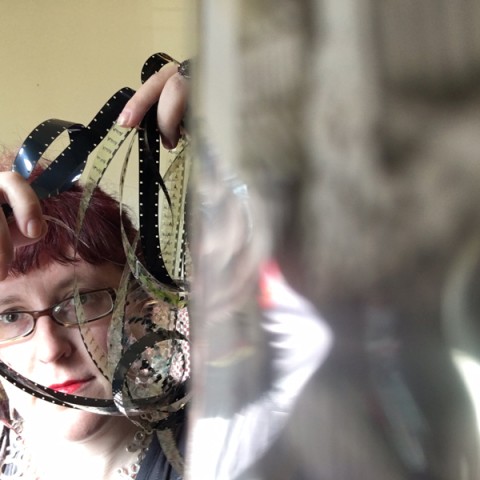
In SmokeLong‘s “Why Flash Fiction?” series, flash fiction writers and editors explore what draws them to the form, from the first time they wrote a piece of flash to why flash resonates with them. In this column, writer, artist, and filmmaker Georgia Bellas discusses how a handcrafted film animation class illuminated flash fiction writing for her. Submit your own “Why Flash Fiction?” article or other flash-related essays on our Submittable page!
By Georgia Bellas
Twenty-four frames per second. There are 40 frames in a foot of film, approximately 1.6 seconds. Four hundred frames equals 10 feet equals roughly 16 seconds of film. What can you do in just 16 seconds?
My animation teacher counted aloud, one one-thousand, two one-thousand, three one-thousand, four one-thousand as she stepped, twirled, spinned, jumped. You can complete a dizzying array of actions in 16 seconds, more than you’d think possible when you hear the word seconds, a unit of time that can also be described as a “flash.” It happened in a second, it happened in a flash.
Holding the film in your hands, letting it spill out across the table, you see time in a different way. You see one second, you see 16 seconds. They are tangible, a physical visualization of something as slippery and bodiless as the idea of time.
You can hold time in your hands, look at it with your eyes. That second that passes so quickly is suddenly measurable, a length of film you can see and touch. It now seems long. And 16 seconds? I spread my arms wide open and the film stretches beyond my fingertip to fingertip reach, falls to the floor. Sixteen seconds of film is longer than the wingspan of a red-tailed hawk.
If you want to read a word you have to write it 24 times, in one little box after another. Methodical, repetitious, sometimes tedious, often meditative. Twenty-four times will get you one second. A flash.
Ten feet of film spins through the projector, enchanting flashes of light and color and movement that flicker across a screen for 16 seconds and stop, giving you enough and yet leaving you wanting more.
You experiment and project — see what you drew, what materials you used, what effects you tried, and how it all translates visually on a wall. Sometimes you get what you imagined. Sometimes you don’t. And sometimes you find the magic, the unexpected pleasure that keeps you going.
Flash is like these handcrafted animations. You have a limited space — under 1,000 words, or 700 or 500 or 300, whatever limits you define it by. That length is your 16 seconds to make things happen, make your characters walk, jump, skip from frame to frame. Make them come to life.
You spend hours laboring over words, your tiny frames of film. What can you fit in those tiny rectangles? Do you work frame to frame, moving in minuscule increments or do you concentrate on the flow and movement over the frames?
Because the writer is an animator too. You create a world that plays out, feels complete and yet draws you back to the beginning to read over and over, finding more and new nuances each time. It’s like the magic of film. Rewind and play it over. Look again.
Use the minimum amount of space and time and materials to tell a story. Labor, labor, labor over every frame, every word. Many constraints, infinite possibilities. Invest hours into something that yields only minutes, or even seconds.
A flash of light. A flash of words. A flash of heart.
This essay was inspired by a class I took on handcrafted film animation by the amazing Gina Kamentsky. Watch one of her films here.
 Georgia Bellas is a writer, artist, and filmmaker. Her work appears in a number of journals, has been nominated for a Pushcart, and is included in Sundress Publications’ 2014 Best of the Net Anthology. You can follow her teddy bear, host of the award-winning weekly Internet radio show “Mr. Bear’s Violet Hour Saloon,” on Twitter @MrBearStumpy.
Georgia Bellas is a writer, artist, and filmmaker. Her work appears in a number of journals, has been nominated for a Pushcart, and is included in Sundress Publications’ 2014 Best of the Net Anthology. You can follow her teddy bear, host of the award-winning weekly Internet radio show “Mr. Bear’s Violet Hour Saloon,” on Twitter @MrBearStumpy.

 The core workshop of SmokeLong Fitness is all in writing, so you can take part from anywhere at anytime. We are excited about creating a supportive, consistent and structured environment for flash writers to work on their craft in a community. We are thrilled and proud to say that our workshop participants have won, placed, or been listed in every major flash competition. Community works.
The core workshop of SmokeLong Fitness is all in writing, so you can take part from anywhere at anytime. We are excited about creating a supportive, consistent and structured environment for flash writers to work on their craft in a community. We are thrilled and proud to say that our workshop participants have won, placed, or been listed in every major flash competition. Community works.